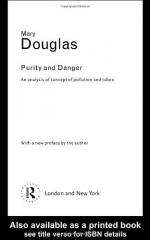|
This section contains 327 words (approx. 1 page at 400 words per page) |

|
Chapter 1 Summary and Analysis
Studying purity and pollution involves understanding various religious concepts related to contagion and the sacred. Primitive views have more than just mechanical symbols and contain ethics. Comparative religion has been wrongly assumed to be based on false beliefs in magic. The relationship between science and magic is unclear.
Greek studies of purity and impurity involve classical dramatists. The concept of contagion as part of the Old Testament is assumed to be part of pollution through sin, although a mechanical process. The union between God and people involved struggle. Contact with primitive cultures instilled primitive cultures that used primitive rituals.
Frazer had contempt for primitive society through preconceived judgments, irrational, and childish ideas. Frazer assumed that only advanced civilizations had ethical refinement, and claimed that primitive culture thought through magic and was confused and foolish. According to him, magic had wrong assumptions...
(read more from the Chapter 1 Summary)
|
This section contains 327 words (approx. 1 page at 400 words per page) |

|




